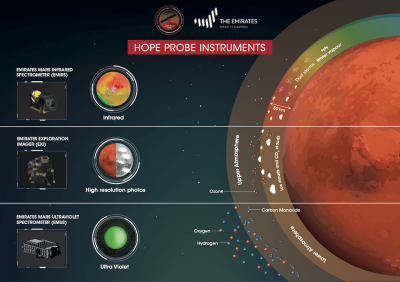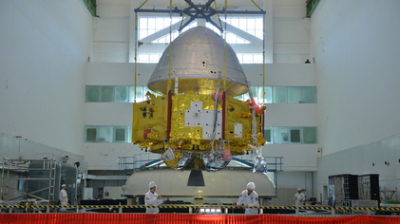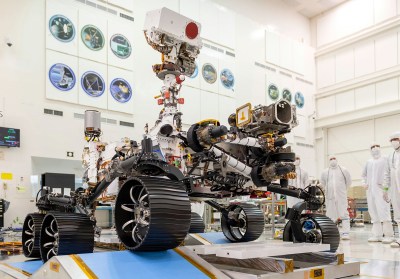Mars may not be the kind of place to raise your kids, but chances are that one day [Elton John]’s famous lyrics will be wrong about there being no one there to raise them. For now, however, we have probes, orbiters, and landers. Mars missions are going strong this year, with three nations about to launch their rockets towards the Red Planet: the United States sending their Perseverance rover, China’s Tianwen-1 mission, and the United Arab Emirates sending their Hope orbiter.
As all of this is planned to happen still within the month of July, it almost gives the impression of a new era of wild space races where everyone tries to be first. Sure, some egos will certainly be boosted here, but the reason for this increased run within such a short time frame has a simple explanation: Mars will be right around the corner later this year — relatively speaking — providing an ideal opportunity to travel there right now.
In fact, this year is as good as it gets for quite a while. The next time the circumstances will be (almost) as favorable as this year is going to be in 2033, so it’s understandable that space agencies are eager to not miss out on this chance. Not that Mars missions couldn’t be accomplished in the next 13 years — after all, several endeavors are already in the wings for 2022, including the delayed Rosalind Franklin rover launch. It’s just that the circumstances won’t be as ideal.
But what exactly does that mean, and why is that? What makes July 2020 so special? And what’s everyone doing up there anyway? Well, let’s find out!
A Window To Mars
Even the simplest model of our solar system will show how Earth and Mars revolve differently around the sun, with distance and speed being the most obvious ones. Earth rotates in a distance of roughly 149,597,870.7 km 1 astronomical unit (AU) from the sun at an average speed of 29.78 km/s, while Mars does the same at ~1.523 times the distance and an average speed of 24 km/s. It takes Earth ~365 days to end up in a same spot again, and Mars ~668 amounts of its own definition of a day, i.e. sols, which is roughly the equivalent of 687 Earth days.
Throwing around all these numbers shows mainly one thing: Earth and Mars don’t have much in common here, and as a result, they don’t hang around much in each other’s proximity. Still, they do revolve around the same sun, and are therefore bound to meet on occasion. Okay, “meet” is a strong word with fatal results if taken too literally here, but rather have close encounters with each other. The accurate terminology would be that they are in opposition on occasion.
Opposition

Every time the Sun, Earth, and another celestial object are aligned in a way that you could draw a straight line through them, they’re said to be either in conjunction, or in opposition, depending on which side of the sun that third object is. If the arrangement is in conjunction, the object in question has the furthest possible distance from Earth, usually having the Sun between them, while in opposition, it’s as close as it’s ever going to get in that specific moment of proximity. Mars is in opposition with Earth on average every 780 days: 2 years and 50 days. That means in theory, there’s a great opportunity to travel to Mars every 780 days.
However, opposition as reference for a launch window isn’t only about traveling the shortest possible way for resources reasons, but to do so in a perfect time frame to match the speed and trajectory of everyone involved, and make sure there is an actual chance of our rocket meeting our object of desire — in this case Mars. Let’s not forget that we’re dealing with giant objects moving with unimaginable speed through space here. They may be close to each other in a relative sense, but we’re still talking about millions of kilometers distance between them.

The thing is, we can’t just launch a rocket along that imaginary line in the moment of opposition. Not only will it take months to reach there, the rocket also has to travel in an elliptical orbit that matches up between Earth and Mars. Doing so on the shortest possible distance simply has the highest chance for success. Launching too early, the rocket might have to wait unnecessarily long for Mars to catch up, wasting fuel and potentially running out of it altogether. Launching too late, and it’ll end up like Wile E. Coyote desperately chasing the Road Runner — minus the rocks and cliffs.
As a result of all that, Mars missions happen indeed roughly every 2.x years, launching usually a few months before the opposition itself, and landing / entering orbit a few months after the opposition then.
Looking at the history of the last few oppositions and the launch dates of the missions at that time, it all adds up:
- Mid October 2020 – our 3 missions in late July
- Late July 2018 – 2 missions in early May
- Late May 2016 – 2 missions in mid March
- Early April 2014 – 2 missions in early and mid November 2013
- Early March 2012 – 3 missions in early and late November 2011
We can go back as far as October 1960 with this, when the Soviet Union (unsuccessfully) attempted the very first launch to hit the window in late December that year — and of course 1965 when NASA’s Mariner 4 performed the first successful flyby of Mars. While this shows a steady amount of launch windows over the years, it also shows that missing the opportunity will cause a definite delay until the next windows opens — as it happened with the InSight mission in 2016, and the previously mentioned joint mission between ESA and Roscosmos this year.
There are two other things noticeable in the mission history excerpt above: I’m quite vague about the dates, and the period between mission launches and opposition varies. Let’s get into the date vagueness first by taking a look at the actual launch windows.
The Window
While there is a definite time we can attach to the opposition and the closest proximity, we don’t have to be at a specific point at a very specific time here, but have a bit of tolerance — hence launch window. The exact width and location of that window varies on different factors like the rocket and its trajectory, and is individually determined for each single mission.
For example, as shown above, there were two launches at different periods back in November 2013 for the April 2014 opposition. India’s Mars Orbiter Mission (MOM) had a window from October 28th to November 19th and was launched on November 5th, while the US’s MAVEN had a window from November 18th to December 7th, and was launched straight away on its first possible launch date on November 18th.
Each day within the launch window has usually its own window of a very few hours for a rocket to launch in hopes to rendezvous with another object. Remember, everything is rotating and spinning in all sorts of directions in space, so depending where on Earth you launch from, you have to account for that as well.
Considering that a launch also depends on weather conditions, it’s a good thing that there is usually a ~3 weeks window for each mission, which explains my vagueness on the mission times earlier. But what about that shift between the launch frame and opposition time then? Well, nothing is going perfectly round up there in space.
Eccentricity

In an ideal world, the planets would rotate in a perfect circle around the sun, having the same distance to it at any given time. In the real world, it’s all a bit off-center though, and eccentricity causes a variation of the distance over the (local definition of a) year. For example, the apsides of Earth, i.e. the closest and farthest points from the sun, differ around five million kilometers — or five gigameters (Gm) — within the year, This may sound like a lot, but at an average distance of ~150 Gm, its eccentricity is a low 0.0167. It’s still enough to have spring and summer a few days longer than autumn and winter, and as someone living close to the Arctic Circle, I can certainly appreciate this.
Mars is, after Mercury, the most unbalanced planet in our solar system, with an eccentricity of 0.0934 that places its apsides at ~206.6 Gm and ~249.2 Gm respectively. Since the timing of opposition occurrences don’t add up to either of the planet’s orbital period, their moment of closeness always happens at a different place within their orbit. As a result, the actual distance of each opposition varies, and with it, the time it takes to travel. However, it falls within a similar range every 15 to 17 years.
Currently, we’re in a good position where Mars and Earth are on the lower end with their distance during opposition at 62.07 Gm. However, it’s also not as good as during the 2018 window’s 57.29 Gm, or the all-time low record in 2003 of 55.76 Gm — not counting that one encounter back in 57,617 BC. However, seeing that the distance increases again, it is as close as it gets until 2033 and 2035 with their 63.28 Gm and 56.91 Gm respectively — here’s a list if you want to check more. Looking at those years, the “every 15 to 17 years” parts really adds up.
That list also shows that the Soviet Union’s series of missions back in 1971 that resulted in the first lander on Mars, along with the United States’ Mariner 9 as first orbiter, all happened at a good time with a opposition distance of 56.20 Gm. Unlike the previous Mariner 4 mission in 1965 at almost double the distance of 100.00 Gm — which makes its success on the other hand even more impressive. Comparing it with all the Mars missions, it might also explain why there were barely any launches between the two Vikings in 1975 and Pathfinder in 1996, with the Soviet Union once again using the best window back in 1988.
This also shows that even the worst case scenario won’t stop Mars missions, so even though the conditions won’t be as ideal as in 2018 or this year until 2033 — which incidentally matches everyone’s current time frame for sending humans to Mars — we definitely won’t have to wait that long to see more rockets launched towards it.
But let’s not rush off into the future, after all we have a whole series of launches just waiting to happen right now. So what’s that all about then?
2020 Mars Missions
As mentioned in the beginning, three different countries will each launch their own independent mission this July. In the grand scheme of Mars missions, this is the first time we see this happening — the same number of countries were involved in 2011, but Russia and China had a single, collaborative launch back then. This time, it’s actually three independent missions.
Some more fun facts about this year’s run to Mars. Assuming that all three missions succeed, it will be the first time an Arabic nation is on an interplanetary journey. Further assuming that Curiosity remains active, it will break the record of active rovers roaming Mars’s surface, and the first time a non-US rover is one of them. We can also expect to see the first drone footage from Mars!
While that’s all great, it’s hardly all there is to it though. So what else can we expect from these missions?
United Arab Emirates
First up in the schedule is the United Arab Emirates (UAE), which had to postpone their initial July 16 launch due to bad weather conditions in their launch site in Japan for three days. The good news is, their launch window had just opened on July 15th, and would have remained open until August 12th, so there wasn’t too big time pressure yet. But there was no need for further delay, the weather conditions improved, and in the early Monday morning hours local time — July 19th, 21:58:14 UTC — their HII-A rocket successfully took off from the Tanegashima space center.

The mission will send their Hope probe into Mars’s orbit, where it will record everything about the atmosphere with the main objective to create “the first complete picture of the Martian atmosphere”. Their goal is to research the climate dynamics on Mars — essentially creating the first full weather map of Mars — and how the escaping hydrogen and oxygen play into that and why it’s escaping in the first place. The probe itself is equipped with three imaging instruments: an infrared spectrometer, an ultraviolet spectrometer, as well as a high resolution imager.
While the mission’s main focus is naturally on the research itself, the UAE takes this also as an opportunity to demonstrate their newly achieved position in space exploration, especially as a rather small nation. Aiming to inspire future Arab generations to pursue the field of space science, they want to establish themselves as “beacon of progress in the region” and show that nothing is impossible. Considering the achievements the Islamic world once contributed to humankind during its Golden Age, the UAE’s hope is also to commemorate, if not revive, the region’s importance within astronomy.
China

The second mission is China’s Tianwen-1, scheduled to launch on 23. July. After the joint expedition with Russia in 2011, which unfortunately ended unsuccessfully as the rocket failed to leave low Earth orbit, China conducts their second-ever attempt to travel to Mars on their own — and doesn’t appear too eager to share much details about the mission itself or the instruments involved.
From what is known and speculated, Tianwen-1 is a full-blown, all-inclusive mission with orbiter, lander, and rover on board, unlike the previous mission which was just an orbiter. While parts of its objective will also look into Mars’s atmosphere, it’s assumed that the main focus lies on and below its surface. The main objectives seem to include creating a geological map, exploring soil characteristics, and finding water-ice pockets — also in hopes to find evidence of past and possibly present life on Mars.
United States

Finally, the third mission, the US’s Mars 2020 mission, is expected to launch the Perseverance rover with its Ingenuity drone on July 30th — the first day of the its launch window that closes on August 15th. And even though the US has made it to Mars numerous times before, an endeavor like this is hardly ever a routine operation, and there’s just as much at stake as for the other two countries.
Continuing the work of the Mars Exploration Program, Perseverance will look for past life on Mars, specifically microbial life, by collecting soil and rock samples. The idea is that a future mission could either bring further equipment to Mars to analyze those samples, or bring them back to Earth, whichever seems more feasible at that time. [Dan Maloney] wrote about the details earlier this year, so if you’re interested in it, go check it out.
Final Words
There are certainly some exciting days ahead of us, followed by weeks and months of enduring until we will see the actual outcome of all the launches, as all three missions are expected to reach Mars in February 2021. What will come of it? We’ll just have to wait until next Spring to find out.
As for sending humans to Mars, they’ve missed this window, so that’s still at least a good decade ahead of us for now. And nothing’s going to change the orbital dynamics of the situation.















Shit you learn playing KSP …
of course in ksp the solution to this and every other problem is moar boosters.
Nicely done. Very informative.
As humans we can just barley make it in Antarctica due to the extreme cold. That does not even compare to how cold it’s going to be on Mars. At least here we can breathe, there your just screwed. I get man has to concur things to feel alive, and to have purpose, and i know its boring. But how about using all that money and resources to fix things here first.
“But how about using all that money and resources to fix things here first.”
Because it won’t fix anything here, too many ideas (many contradictory) of what needs to be done.
Whereas, each Mars mission has specific goals.
Nirvana fallacy.
The NASA estimate 100 billion US dollars to put man on Mars would pay a million poor Americans ten years of minimum income, and would improve the economy instead of just paying rich aerospace corporations.
At first, I thought you were criticizing my comment, instead of supporting it.
“The nirvana fallacy is the informal fallacy of comparing actual things with unrealistic, idealized alternatives. It can also refer to the tendency to assume that there is a perfect solution to a particular problem. A closely related concept is the perfect solution fallacy.” -Wikipedia
So, the actual thing is “rockets to Mars”, while the unrealistic, idealized alternative is how the Earth will become a utopia by re-purposing a few billion dollars. (when trillions won’t do the job).
>how the Earth will become a utopia by re-purposing a few billion dollars
Now that’s an appeal to extremes. A hundred billion spent on the poor will do greater things to the economy and society than shooting a hundred billion up the sky to profit the already rich aerospace corporations, simply because one course of action slightly diminishes the general income disparity while the other slightly increases it.
If you argue that a small step in a wrong direction is justifiable because it is only a small step, you can multiply the same for any and all other cases where relatively insignificant amounts of pubic money is mis-spent to benefit the few, and arrive at exactly the present situation that we are suffering.
Besides, the Nirvana Fallacy really refers to the case where a proposal is dismissed because it does not adhere to some arbitrary standard of perfection, the “Nirvana” case.
It is dismissing a good option, because it is not the unattainable best. You simply committed the fallacy twice. It’s like saying, “We don’t have enough money for a restaurant, therefore we should not buy a loaf of bread to eat.”
Besides, space exploration contributes to the progress of the human race. It would make more sense to get mad over something like military spending, which doesn’t help humanity move forward at all.
im convinced we could roll all u.s. entitlement programs into a single unified mincome system, replacing all existing systems, and it would cost less by the money saved in the greatly reduced bureaucracy.
No you’re not paying rich aerospace companies. The 100 G pays a lot of skilled worker salaries. All that money is being pumped back into the economy. It gets a return rather than just giving it away with no value being received.
Thank you – I came down here to say much the same thing but you hit the key problem with minimum income. There’s no value received except the placation of the unemployed and the minds of those who look at them as hopeless. Minimum income perpetuates dependence. Job and skill training leads people to a productive life with nominal independence, not to mention human dignity.
I’d also like to point out that even military spending has advanced man kind. Radar, Lidar, life saving trauma tools and techniques and a very long list of other things came about because necessity is the mother of invention. So long as people have differing opinions and the certainty that they are more right than their fellows, we’ll have wars, as sad a statement on the human condition as that may be.
Because getting to space is a lot cheaper and easier than fixing a lot of pressing issues here on Earth, among numerous other reasons, including the fact that some of those problems can’t simply be corrected with money. That, and having self-sustaining habitation off this planet might be the one thing that saves the human race from annihilation, sadly.
I also suspect that all your personal resources, in terms of both time and money, outside of that necessary for your own survival, doesn’t go towards addressing the issues you’re thinking of.
Getting drunk is a lot cheaper and easier than fixing a lot of pressing issues as well, therefore it is wise to ignore these issues and continue spending the money on booze.
Duly noted.
If there’s no practical means of fixing your problems, and boozing makes your life more tolerable, then perhaps it is the right choice. It might not be ideal, but sometimes none of the other options are either.
I’m not saying we shouldn’t strive and work towards making the world more equitable and stop doing environmental harm, but not all problems have known solutions, or have solutions that won’t adversely affect some party at the benefit of another. In reality, while the NASA budget might be able to make a few dents in some of the problems (despite the fact that there are better places to save money via reforms), the political landscape surrounding them is unfortunately so touchy that the gov would be more apt to simply not fund anything rather than divert the NASA budget to some of these issues. Humanity’s greatest issue IMO is that a huge percentage of the population lack the ability of critical thought, and thus are easily duped, or succumb to emotion rather than reason.
But I still maintain that just because something is broke doesn’t mean it has to be fixed before you can do anything else. It might not seem fair, but that’s just a human (and some animals, to a lesser extent) concept. Nature doesn’t give a shit. So while we should strive to make things better (and in many ways, we do), we should still be allowed to enjoy ourselves every once in a while, which sometimes means fantastical things such as placing robots on another planet. After all, there are worse ways to spend money.
No matter how much money you throw at it you will always have poor people
i practice something similar to this philosophy. the only difference is i have substituted booze for marijuana.
>one thing that saves the human race from annihilation
You can bet that the list of people to leave earth will be very exclusive and not representative of all the peoples. The vast majority of humanity will be left to die.
You’re probably right. So are you saying it’s better if everyone dies rather than most people? Not that I believe there is actually a correct answer. The thing is, if you’re concerned with the issues that affect humanity, then I would think you’d have to be concerned with the survival of the species, regardless if the only ones to survive are part of some exclusive group (BTW If by “exclusive”, you mean “wealthy”, I think the wealthiest would stay on Earth because the moon and Mars kinda sucks).
“As humans we can just barley make it in Antarctica due to the extreme cold.”
I disagree, they present oatally different challenges.
Wheat need to preserve triticale endangered resources!
You have a rye sense of humour.
With an attitude like that humanity would have never gotten anywhere and frankly I’m glad my ancestors didn’t say “Why spend all our resources leaving Central Africa lets just fix things here.”
The desire to ‘fix things at home first’ isn’t without merit, especially if it’s a zero sum resource allocation. That said, of the resources that could be reallocated to improve conditions on the home front, there are much bigger sacred cows to slaughter in the Federal budget. A perennial example is the defense budget. A recent and and (imo) especially pernicious example being the Tax Cuts and Jobs Act of 2017, which deficit finances a US$1.8T transfer of money to wealthy US residents. In this context, whinging about NASA is a red herring.
It’s worth mentioning that the minimum-energy transfer orbit is https://en.wikipedia.org/wiki/Hohmann_transfer_orbit , though the finer points involve taking into account the change of plane required due to the two planets’ differing orbital planes.
And a really great hack for visualizing departure & arrival dates and the velocities required is https://en.wikipedia.org/wiki/Porkchop_plot
See also NASA’s pablum description of the porkchop at https://mars.nasa.gov/spotlight/porkchopAll.html
For those who wish a bit more meat in their intellectual fare: https://trs.jpl.nasa.gov/bitstream/handle/2014/44336/13-0679_A1b.pdf
Interesting porkchop reads, thanks!
There’s a link to the Hohmann transfer orbit Wikipedia article in the Opposition section, but I guess I could have been more explicit about it. So good thing it’s linked here as well now.
Call me ignorant all (you) want, but my opinion on this – We shouldn’t be trying to go to Mars, if we can’t even fully get along on Earth.
Disagree. We will ‘never’ ‘get along’ fully here on Earth. Forget that. There is always someone, some group, or some nation that wants to tear down society over wealth, power, greed, envy, drugs, ideology, theology, etc. Even in the USA here, we have the marxist BLM and AOC crowd (and other groups) trying to tear down the American way of life from within. Erase history if possible.
No, better to spend money (what little is allocated, thank goodness for private ventures) on reaching out to the stars and exploration. Solving ‘hard’ problems together, finding new materials, new techniques to make it happen. It also puts a lot of people to work with good paying wages. Allows people to dream big. Allows nations to move ‘forward’ instead of stagnate and into decline. To be proud of accomplishments. Man ‘needs’ a frontier to explore. It is in his nature. Space is a great (infinite?) outlet.
Thanks for the article. Very informative. Enjoyed it. Now if we can just find a power source that gets us around the universe more efficiently than chemical rockets so we don’t have to worry so much about conjunction and opposition :) to conserve fuel and time. Just go there…. Dream big.
“Even in the USA here, we have the marxist BLM and AOC crowd (and other groups) trying to tear down the American way of life from within. Erase history if possible.”
*facepalm*
HAD really isn’t the venue for politically bent commentary, especially ones that are so ill-conceived. Maybe save it for the rest of the internet.
“HAD really isn’t the venue for politically bent commentary,”
At least not a venue for politically “incorrect” bent commentary…
(Mike S. deleting comment in 3… 2… 1….)
so I guess its the BLM walking around wearing swastikas and such? I don’t know what reality you live in….
and lets keep that keep the American way of life just the way it is, since it obviously works for everyone
That’s a tired argument. Do you not go beyond basic survival necessities despite all the troubles and difficulties humans and nature pose? I’d argue that there far larger frivolous expenditures of both national and personal treasure than the budgets allocated for these programs. That might not make this excusable, but I think there are far better places for you to set up your soapbox than around these relatively insignificant space programs.
Worse Problems Fallacy.
When you follow the line of reasoning you present, nobody can say anything about any of the other frivolities either, because all the rest of them demand greater attention. Hence, nothing gets done because. Everywhere you go, you always get told to take your soapbox elsewhere.
I think imperative that one chooses their battles wisely. Maybe I’m just short-sighted and it is actually better to choose smaller targets from which the fat is cut, rather than some of the more egregious ones. Don’t get me wrong, I take issue with a variety of NASA programs, especially those that are redundant, or could benefit from international cooperation.
But my main point was that of hypocrisy. Yes, in light of numerous pressing issues right here at home, many (but not all) NASA projects seem frivolous, but does that make them entirely unacceptable? To find out, let he who is without frivolity cast the first stone. Is it so wrong of me to expect people to lead by example, rather than just having them dictate how they think things should be without putting any of their skin in the game?
Why do people go to war on earth:
My god(s) is better than your god(s), believe in my god(s) and/or die.
We want your food.
We want your sources of clean water.
One group wants the land of another to expand.
We want your sources of energy.
We want your natural resources.
So ultimately you want to reject the near infinite resources and power sources that are available today in space to remain on earth as a species and continually kill each over the limited sources here. As a species, the eventual long term survival depends on expansion into space. At a minimum to move all the eggs out of one basket, in case of disaster. The human species could easily be extinct, all it takes is one impact event with a large enough astronomical object. Even something minor like a Yellowstone supervolcano eruption which might not lead to human extinction, but would definitely make life difficult, the increased sulphur would produce acid rain killing large amounts of vegetation (food).
If every individual person on earth had access to infinite resources, would some still try to kill others – unfortunately the answer is going to be yes.
Maybe you are right and we should have stayed in the ocean, crawling onto the land and learning how to walk was just a bad idea.
Dear Everyone-who-thinks-space-travel-is-a-waste,
A very high proportion of technologies that we use today are invented when we endeavor to do what may seem impractical or even impossible. Be it smashing particles together, traveling to space, developing new weapons, exploring our planet, or observing the universe, these endeavors uncover the unknown and push the boundaries of our scientific understanding.
Exploration of the unknown sows the seeds of practical engineering advancement. If you’re looking for wasteful spending there are plenty of places to look, but space travel is not one of those.
/soapbox
Great article. Thank you.
Had never seen the following site before, but your comment caused me to think “I’d read a HAD series on space program spinoff technologies”, then I thought there’s probably already a lot of information on that. And then, Google told me about: https://spinoff.nasa.gov/
Might be interesting reading.
NASA makes a lot of spin-off claims for technology that actually existed before NASA re-purposed it and re-sold it as an accomplishment of the space program.
Mostly they fund private corporations to do private development, which is then sold off to private markets, and the space program is simply tangential to the effort, or a mere excuse.
Yet the manned missions to Mars only establish the practical engineering of setting up a colony in Mars for all the rich people who can afford to rocket themselves there and escape earth. It has no ultimate scientific value that couldn’t be done remotely.
What, did you think the “backup option” for humanity included all the poor and the lower strata of society?
You make it sound like it will be a pleasure planet.
Average outside temperature -63 °C (-81°F)
Minimum temperature, midnight at the poles during winter -153 °C (-225 °F)
Maximum temperature, noon at the equator during summer 20 °C (70 °F)
Humans if living there would choose to be closer to the poles than the equator, to have easy access to ice (water).
If the sealed insulated container you are in fails you die.
Mars has no magnetic field and because of that it has a extremely thin low pressure atmosphere (due to solar winds blowing is away). On Earth the standard sea-level air pressure is 1,013 millibars, for Mars the surface pressure varies through the year (with distance from the Sun), but it averages between 6 to 7 millibars. Water on earth boils at 2.4 °C (36.7 °F) if the pressure is 6 millibars.
Until all the bugs have been worked out and solutions in place, I honestly do not see it as a place that the ultra rich from earth would go.
You also need to live underground for protection from the background radiation, all those charged particles that earths magnetic field redirects safely to the poles that are mostly dissipated in earths thick atmosphere (aurora lights) does not happen on Mars. The thick atmosphere also shields from non charged particles, so dwellings would need to be under at least five meters (~17′) of soil to provide the same level of protection.
I do not picture living on Mars as a pleasure planet, more like a living hell. If anything fails you are dead.
One thing that that needs to be remembered, is that the billions of dollars don’t get put in the rocket and sent to space.
The money is spent on Earth, and helps pay the wages of thousands directly and indirectly. I’m not saying that the distribution of that money is perfect (company profit, bonuses, and don’t even get me started on cost+contract), but it’s not put in a shredder and burned
“developing new weapons, exploring our planet,”
At first I though it’s “developing new weapons, exploding our planet,” which we are heading for with weapon development.
Anyway fully agree with you.
Totally agree abut the missing Porkchop plot. A single beautiful image could answer the question in the article title perfectly:
https://caseyhandmer.files.wordpress.com/2020/04/finalnovenus.png?w=1920&h=768&crop=1
Elon, Nasa, UAE… is it possible to take care of earth, first?
Zucky, you gave $400 Millions to GIPHY, Microsoft gave $21 Billions to Linkedin.
Don’t you think Ocean deserves a bit of that?
Bernie Taupin writes the lyrics. Elton writes the music.
Put them birch trees on mars they grow everywhere and spead like wild flower they bread like rabbits they grow on houses on roads everywhere and them butterfly trees grow on roofs top of empty buildings
Why fight? If every story about space is fake….